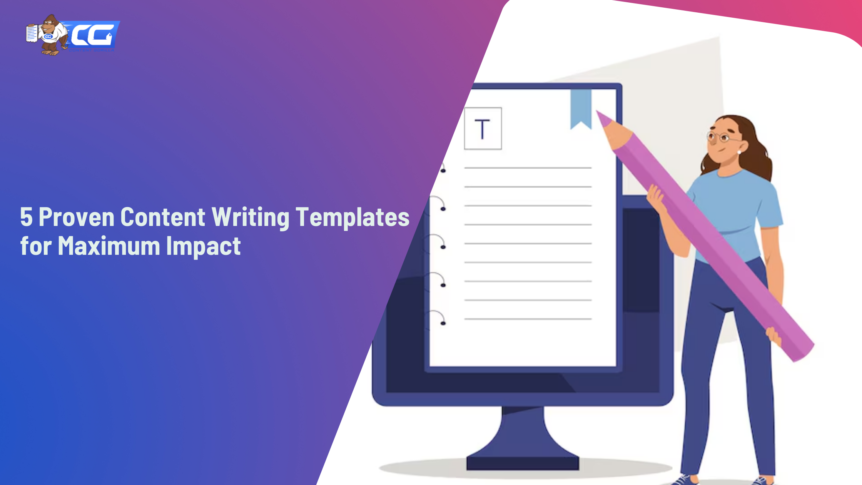Do you struggle to organize your thoughts and create engaging content for your audience? Well, with the right approach, it can be easier than you think. A great content writing template is all it takes to boost your writing productivity and quality!
Source: Freepik
A content-writing template keeps you on track so you can concentrate on the main idea you’re writing about. This way it helps you create on-point and attention-grabbing content that captivates and resonates with your readers.
Let’s dive into what a content writer template is and why one needs it. We’ll also share the best content writing templates with you, so gear up! They can make a real difference in your writing journey!
What Is a Content Writing Template?
Source: Freepik
A content writing template is a reusable structure that outlines the key components of a content piece. Generally, it contains sections for an H1 title, introduction, body, and conclusion.
Attributes of a Content Writing Template
The three attributes listed below form the foundation of an excellent content-writing template.
- Structure – Hierarchical organization of the template, i.e. headings, subheadings, sections, and bullet points.
- Guidelines – Rules and instructions about what type of content to include in each section, e.g. key points, examples, or questions.
- Placeholders – Areas pre-filled with sample text for the writer to fill in with their own information, such as dates, names, or other specific details.
Streamline your SEO writing process with this time-saving and easy-to-customize SEO content template.
Benefits of Using a Writing Template
An effective content writing template is super helpful in several ways. It streamlines the content creation process by:
- Providing clear guidance for writing.
- Ensuring consistent style, tone, and format.
- Improving overall structure and quality.
- Facilitating seamless writers’ team collaboration.
- Offering flexibility for various content needs.
- Saving time and effort.
Types of Content You Could Write
Source: Freepik
A content writer’s resume is their previously written content, e.g. articles, listicles, product review blogs, website content, etc. And depending on your writing career path, more could be merrier!
Let’s talk about the popular types of content you could write. That’s so that the next time someone asks you for sample articles, you should have enough in your arsenal. This is not an exhaustive list though, so feel free to venture outwards and explore more types of content.
- Blog posts – Informative articles written on a specific topic to share trends, tips, reviews, or insights.
- Service pages – Content specifically tailored to highlight a company’s products, services, or offerings.
- Press releases – Formal announcements about a company, product, or event written for media and public dissemination.
- Web pages – Content designed for a website, e.g. home page, About Us, and contact pages, to guide visitors about it.
- Listicles – Articles presented as easy-to-read numbered lists, providing digestible information, e.g. top tips, the best way, etc.
If content is king then SEO is the king’s 👑! Read these top-ranked SEO article examples to understand the best practices before writing your own.
Top 5 Content Writing Templates
Here we’ll provide the top 5 content writing templates to make content creation easier for you.
Quick Tip: These templates save tons of effort (+ time) for established writers just as much as novice ones!
Blog Post Template
Blog posts are informative, educational, or entertaining articles that can be written on almost any topic. You can also write them if you love to share your ideas and expertise or are passionate about connecting with the audience. Let’s explore a blog post brief template to help you write conveniently.
| Blog Post Template |
| [H1 Title] – Make it 50-60 characters long. – Include the primary keyword. Introduction – Introduce the topic briefly. – Mention the reason(s) why it should matter to them. – Keep it engaging yet concise, within 150 words. H2 (Main Point#1) – Discuss the first main point. – Elaborate on this point, providing related examples, relevant quotes, or insightful data. – Use bullet points to highlight important points. H3 (Subpoint) – Offer detailed information about the main point#1, including context and outcome. – Discuss any lessons learned or insights gained from the point. H2 (Main Point#2) – Ensure a smooth transition from main point#1 and introduce the next main point. – Give an in-depth explanation, examples, and supporting evidence. – Add related infographics or images for visual aid. <Note that you can extend your article to as many subheadings (H2s, H3s, …) as required.> Conclusion – Summarize key points. – Add call to action. |
Service Page Template
Service pages are specifically curated to showcase company offers in terms of its products/ services, pricing, etc. They address customer pain points and offer ‘their’ solutions. Businesses aiming to convert visitors → customers can consider writing service pages to promote their unique value proposition. Let’s check out the template below.
| Service Page Template |
|---|
| Headline – Include the service name (by targeting a keyword) contextually. – Highlight the service benefit or USP. Introduction – Grab attention by addressing a common pain point or need. – Give a hint at your service. Description – Briefly describe the service you’re offering. – Include solutions to the pain points mentioned above as key features: Feature 1: [Describe the feature] Feature 2: [Highlight another feature] [Add more features as needed] – Highlight how you(r business) help(s): benefits and outcomes. Pricing – Outline different pricing options or packages available for the product/ service. – Highlight any special offers or discounts. FAQs – Answer common questions about the product/ service. Contact Information – Ensure to mention clearly how to contact you for more information or to book the service/ purchase the product. – Include phone number(s), email address, and any other relevant contact details. Call to Action – Add a compelling call to action (e.g., schedule a consultation call, request a quote, etc.). Additional Resources – Provide links to related blog posts or guides, offering further information about the product/ service. |
Press Release Template
Press releases are formal announcements used to share business or organization news with the media. The news can be about launches, events, achievements, or updates. They are best for companies seeking media coverage or widespread dissemination of important information. The following template will help you craft press release content properly.
| Press Release Template |
|---|
| Headline – Make it newsworthy and attention-grabbing. Dateline – Include location and date of release. Introduction – Briefly state the news, highlighting the “what” of it. Body – Provide the announcement’s important details, highlighting the “why” of it. – Add relevant quotes or stats for added credibility. Boilerplate – Include a short company description for reference. Contact Information – Mention contact details for follow-up queries. |
Web Page Template
A webpage is a single page, providing information on specific aspects of a website. Multiple web pages connect and build a website. They are best for businesses or individuals aiming to guide visitors and promote their offerings.
More or less, every business today is digital and owns a website. Hence, web copywriting is a viable option for you! Let’s check out its template.
| Webpage Template |
|---|
| Header – Keep the logo + brand name at the top. – Include a navigation bar with a menu linking to other important website pages. Hero Section Include a: – Prominent image, video, or illustration. – Tagline. – Call to action button (e.g., “Learn More”, “Get Started”). Introduction – Briefly introduce or give an overview of the webpage’s content. – Mention purpose/ goal briefly. Body – Use headings and subheadings (e.g., H2, H3) to structure content into sections. – Add short paragraphs to elaborate on each section. – Include lists (e.g., bullet points) for easy readability. – Incorporate images, videos, or other media to support the text. Conclusion – Provide a closing thought or call to action. Footer Add: – Contact info (e.g., email, phone number, address). – Links to social media profiles. – Copyright disclaimers and links to terms of service, privacy policy, or other important legal documents. |
Having content writing website templates makes your work easier. Now that you have a template, check out how to effectively curate AI-generated website content using an online article generator.
Listicle Template
The word listicle is a portmanteau of two words: listicle + article. Hence, listicles are articles presented as easy-to-read numbered or bulleted lists discussing a particular topic. This format makes the content easy to write and read. Thus, they’re popular among scanners and readers short on time. Let’s explore the template for writing a listicle.
| Listicle Template |
|---|
| Title – Make it catchy and descriptive, highlighting the crux. – Follow this formula: [Number] [Engaging Adjective] [Noun]: [Promise/ Benefit] Introduction – Start with a brief introduction. Body – Elaborate why it’s useful for the reader. – Set the context for the listicle. List Item #1 – Provide a brief description of the first item. – Include supporting details. – Add images/ links if necessary. <Add as many list items as you want> Conclusion – Summarize the article. – Add a call to action. |
Conclusion
Undoubtedly, a content writing template helps you communicate your ideas better. This guide discussed all the ins and outs plus provided you with the top 5 helpful templates. We curated them to help you stay organized and focused while writing. It’s time to say goodbye to writer’s block and hello to high-quality content every time!
To get click-worthy and SEO-friendly title ideas for your curated content try using our Free Blog Post Idea Generator.

I am a full-time online marketer, for over a decade now. Helped over 100,000+ people & generated well over $12M in online sales.

